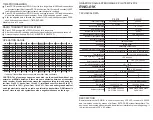
42
WILO SE 10/2022 V05 DIN A4
English COMMISSIONING
5.4.
Electrical connection
RISK of fatal injury due to electrical current!
Improper electrical connections can lead to
fatal electric shock. Electrical connection may
only be carried out by a qualified electrician
approved by the local energy supply company,
in accordance with locally applicable regula-
tions.
NOTICE
Also note all the information regarding electrical
connections in the operating and maintenance
manual for the motor!
• The current and voltage of the mains connection must
be designed in accordance with the information in the
operating and maintenance manual for the motor. See
also the specifications on the rating plate for the motor.
• The power supply cable must be provided by the
customer. The cable cross-section and chosen routing
option must comply with local standards and require-
ments.
• Any available monitoring devices, e.g. sealing chamber
monitoring, must be connected and tested to ensure
that it is working properly.
• Earth the hydraulics according to the regulations.
Earthing is provided by the motor connection. Alterna-
tively, the hydraulics can be earthed through a separate
connection. The cable cross-section for the protective
earth conductor connection must comply with local
regulations.
5.4.1. Check the monitoring devices before
commissioning
If the measured values deviate from the specifications, the
monitoring devices may be faulty. Consult Wilo customer
service.
Optional pencil electrode for sealing chamber monitoring
Before the pencil electrode is connected, it must be checked
with an ohmmeter. The following values must be complied
with:
•
This value must approach “infinity”. If the values are
low, there is water in the oil. Please also observe the
instructions of the optional evaluation relay.
5.4.2. Connecting the monitoring devices
Connecting the pencil electrode (available as an option) for
sealing chamber monitoring
• The pencil electrode must be connected via an evalu-
ation relay. We recommend the “NIV 101/A” relay for
this. The threshold is 30 kOhm. When the threshold is
reached, a warning must be given, or the unit must be
switched off.
CAUTION!
If there is only a warning, the hydraulics could
be irreparably damaged by water ingress. We
always recommend switching the hydraulics
off!
5.4.3. Connecting the standard motor
The information for connecting the motor to the mains, the
information concerning existing monitoring devices and
connecting these devices, and concerning possible activation
types can be found in the operating and maintenance manual
of the motor manufacturer!
5.5.
Operator responsibilities
5.5.1. Recommended monitoring devices
The hydraulics are driven by a standard motor. Standard
motors are not overflow-proof. We therefore recommend
using an alarm switchgear to record major leakages. In the
event of a major discharge of fluid (e.g. faulty piping), an
alarm can be issued and the unit switched off.
6.
Commissioning
NOTICE
Also note all the information regarding com-
missioning in the operating and maintenance
manual for the motor!
The “Commissioning” section contains all the important
instructions for the operating personnel for starting up and
operating the hydraulics.
The following general conditions must always be met and
checked:
• Maximum ambient temperature (see installation and
operating instructions for motor)
• All slide valves on the suction and discharge side are
open
These general conditions must also be checked after a
lengthy period of standstill, and any defects detected must
be remedied!
Always keep this manual either by the hydraulics or in a place
specially reserved for it, where it is accessible for the entire
operating personnel at all times.
In order to prevent damage or serious injury when com-
missioning the hydraulics, the following points must be
observed:
• Commissioning of the hydraulics may only be carried out
by qualified and trained personnel in accordance with
the safety instructions.
• All persons working on or with the hydraulics must have
received, read and understood this operating and main-
tenance manual.
• All safety devices and emergency cut-outs are con-
nected and have been checked to ensure that they work
properly.
• Electrical engineering and mechanical adjustments must
be carried out by qualified personnel.
•
The hydraulics is suitable for use under the specified
operating conditions.
• When working in pump chambers, a second person must
be present. If there is a risk of toxic gases forming, suffi
-
cient ventilation must be ensured.
















































